© 2023 Dr. M. Sheppard
A Pattini ceremony - Pattini Devol Tovil (GamMadua Ceremony)
This ceremony is usually performed as a result of a pledge to the Deity Pattini e.g. when someone, or in this case a village, have been released from a great sickness or misfortune -
Earlier the necessary structures had been erected for the ceremony by the Tovil Dancers, Assistants and with help from the men of the village community. The Performance Area had been sanctified as Deities cannot be invited to attend a profane area. This consecration takes place when the toran for Pattini has been constructed. Chairs typically represent the other shrines to be erected. (For full details of this consecration ceremony and the relevant texts see Obeysekere pages 73-
When we arrived at about 8.00pm, the village men were busily cooking the dana meal in the special cooking place at the Temple. These ritual cooling foods were to be eaten at the conclusion of the ceremony -
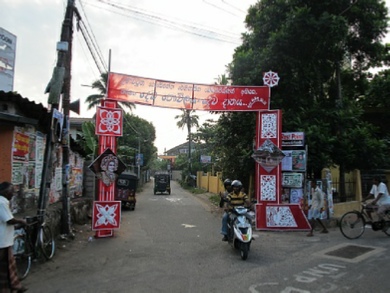
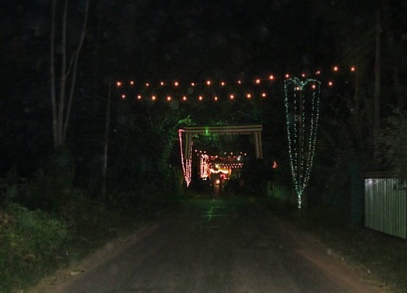
Entrance to the village from the main road. The notice is announcing the Ceremony.
All the way along the side road lights lined the route leading to the Temple where the Ceremony was being held.
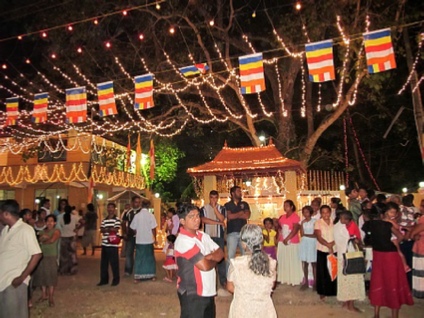
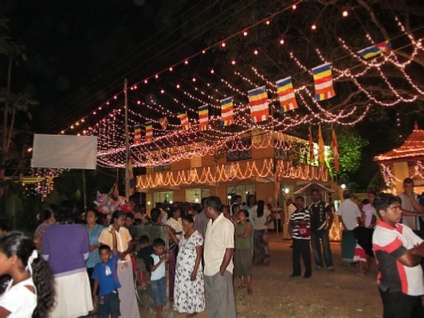
Illuminated Village Temple. There was even a stall set up selling the usual fair ground plastic toys. This was the 30th year this annual Devol-
In the Temple cooking area the men were busily occupied cooking the special food to be given out the next day to all the Villagers. Only men prepare this food. It is a special coconut milk rice mixed with mung beans, cashew nuts, banana and various herbs and spices -
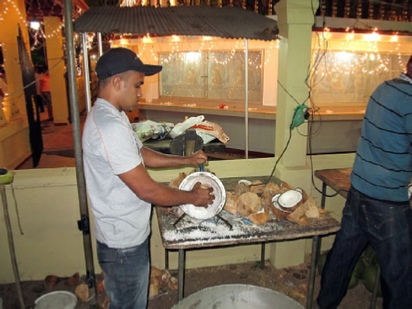
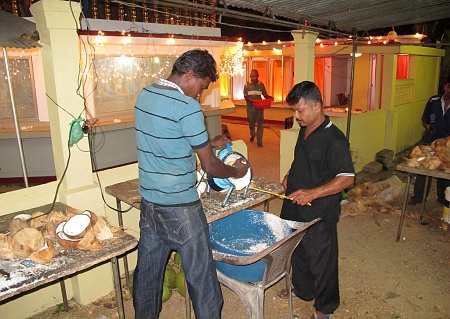
Using a coconut machine to prepare grated coconut to make coconut milk -
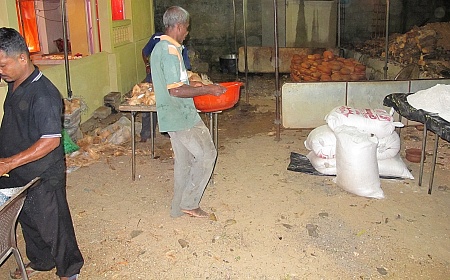
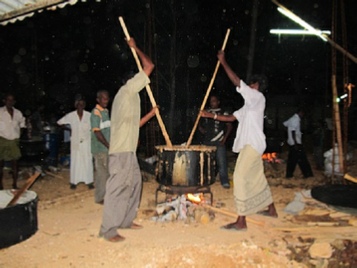
The cooking area. There were men stirring about five of these enormous cooking pots in which the rice was being cooked over wood fires.
Earlier in the day the Temple monks had been “cooked for” and served. This special serving of food to the Monks had opened the proceedings of the Ceremony.
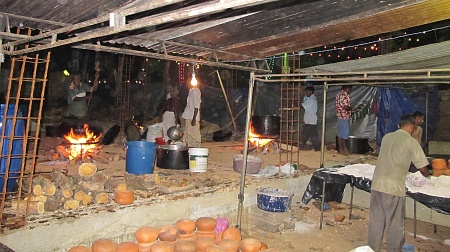
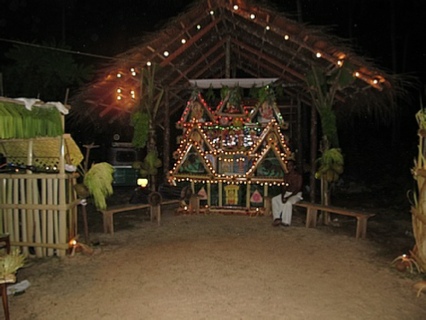
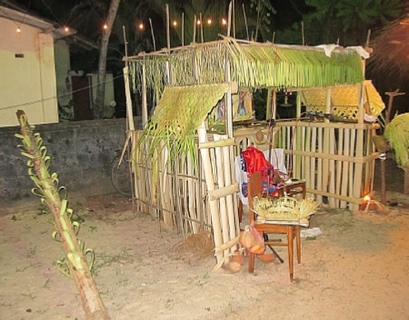
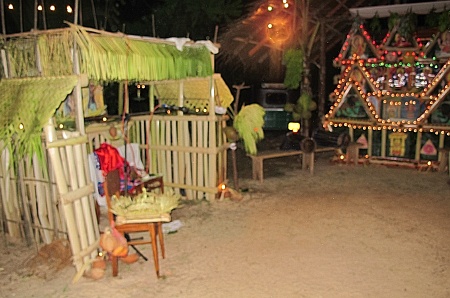
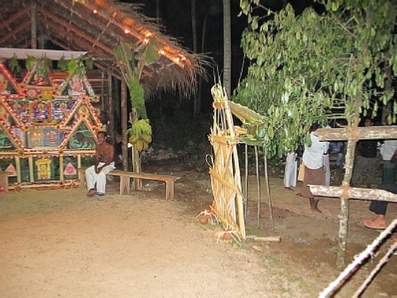
View of the Pattini Toran -
The Performance Area before the start of the ceremony. To the left of the Pattini Toran was the “hut” made of banana and coconut constructed by the Tovil Dancers with the help of Assistants. On the chair is an offering basket. To the right was a smaller specially made structure. In the middle is the Performance Area which had been consecrated and was roped off. This is the sacred area into which the Deities including Pattini are invited to attend the Ceremony which is not only in their honour but also for their entertainment.
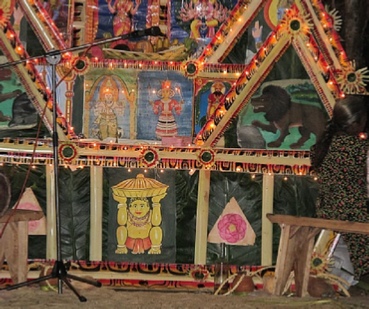
Lord Buddha is depicted in the top row. Below him in the middle two rows are images of Deities including Pattini,Devol-
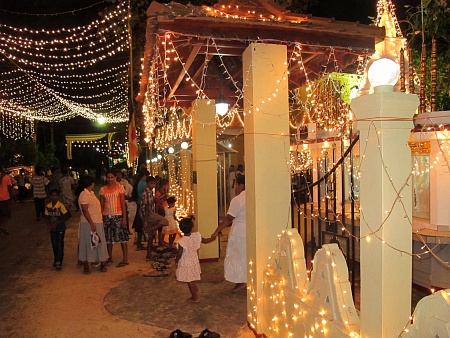
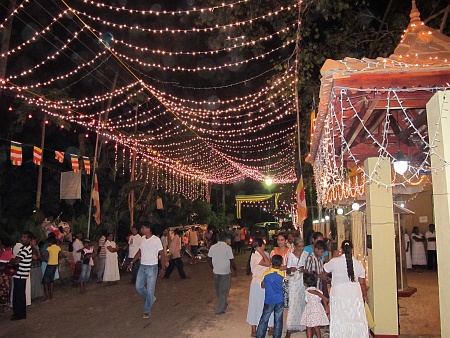
The Temple opposite which has been illuminated for the Ceremony
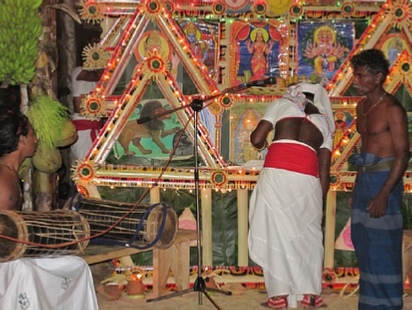
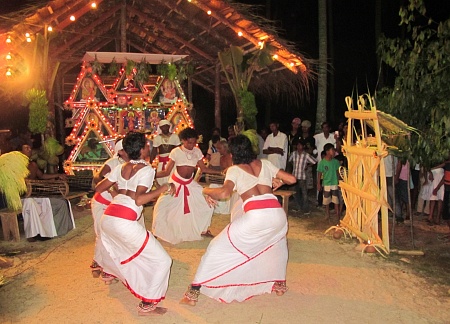
Topping up the oil lamps
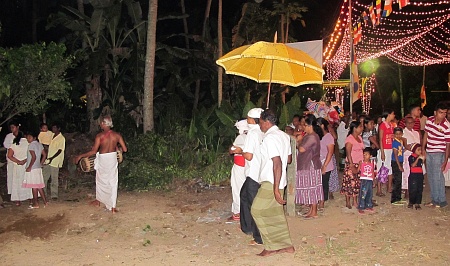
One of the Tovil dancer drummers led as the puja offerings were carried by a community leader. Puja was presented by the Head Tovil dancer at the main shrine in the Temple. Then the procession returned to the Performance Area. White cloths cover the heads of those in contact with the puja offerings
Then the main officiant offered Puja at the Pattini Shrine after offering Puja at the Buddhist temple
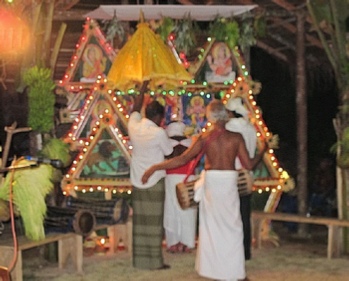
“Restrained” dancing, the dancers represent the servants of Pattini and they are dancing for her entertainment
The specially erected Pattini Shrine had a roof of coconut thatch providing the cover. The shrine consisted of pictures in four rows. On the top layer were images of Buddha. The next layer depicted pictures of the Sri Padha deity -
The ceremony commenced with the Head Tovil Dancer, who was the main officiant, taking a conch shell from the Pattini Toran and blowing it three times. He then replaced the shell carefully in the Toran. Blowing the conch shell denotes an auspicious ceremony connected with the Deities is to take place. Then the coconut oil lights were lit in front of the different shrines-
Next Puja was offered at the Temple opposite and then at the main Toran Shrine of Pattini which had been erected on ground opposite the Temple. The Puja was first led around the sacred Bodhi tree at the Temple by one of the three drummers from the Tovil dancers and the Puja was offered by the main officiant. It was carried by one of the community leaders whose head and mouth were covered by a white cloth to prevent pollution. Another community representative held a golden umbrella over the puja. When they re-
In front of the toran after he had presented the puja to the Shrines, the main officiant first knelt and then fully prostrated himself in front of the toran. Then the community leaders retired to the side of the toran and the officiant and leader removed their head coverings.
Following the Puja the main officiant led the Buddhist chant reciting the Five precepts for which all the audience stood respectfully and participated and then the main ceremony of the evening commenced at about 9 pm. (N.B. For this he had removed his head cloth as whilst offering prayers to Buddha, Buddhists remove head coverings.)
You Tube Video Link
Gam Madua Part 1 Community Gam Madua near Unawatuna
https://youtu.be/q6ipHLYW3BQ
Invitation to the Deities
This part of the ceremony is to formally invite the Deities to attend. The main officiant had again donned his head covering to show respect to the Deities. He commenced by standing in front of the toran and ringing a tinkling bell. This is to initiate the invitation to the Deities.
Then the other Tovil dancers danced in front of the toran.They were dressed in white clothes with red sashes and two of them had head coverings. One of them held bunches of coconut flowers in each hand. The main officiant sang from the texts about what was happening and the drummer beat the rhythm of the dance. The dancing was fairly restrained at first then gradually became faster when a fifth dancer joined, with twirling and acrobatics, sometimes one or two dancers would perform energetically together whilst the others rested. This dance lasted about 15 minutes,
Then they all faced towards the toran and the main officiant took a conch shell from the Pattini Toran and blew it three times. He then replaced the shell carefully in the Toran. Blowing the conch shell denotes an auspicious ceremony connected with the Deities is to taking place. The the coconut oil lights had already been lit in front of the different shrines. The Deities had now been formally and respectfully invited to attend the ceremony, whilst resting comfortably on their “couches” (shrines), and be entertained by the dances, praises and mimes and receive their offerings.
One of the dancers held a large lighted torch which was passed around in turn to the other dancers. Another sang from the texts about what they were doing.
One of the dancers was then given a large lighted torch by an Assistant who held two coal pans of dummala. This lighted torch was to be placed at the top of the Festival Bough before it was “planted”.
The drumming started again as did the singing. The dancer with the torch danced steadily with it in a swaying movement. The other dancers accompanied him in the dance. The Assistant moved from the lighted torch to the nearby spot to the left where the Festival Bough was laid.
This is the beginning of the dances for the Festival Bough.